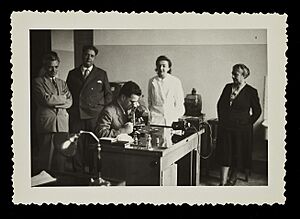Hans Grüneberg facts for kids
Hans Grüneberg (born May 26, 1907 – died October 23, 1982) was a famous British geneticist. He was also known as Hans Grueneberg or Hans Gruneberg. Hans was born in a town called Wuppertal–Elberfeld in Germany. He studied a lot, earning degrees in medicine and biology from universities in Germany and London. In 1933, he moved to London after being invited by important scientists like J.B.S. Haldane and Sir Henry Dale.
In 1956, he became a Fellow of the Royal Society, which is a big honor for scientists. Most of his work was about the genetics of mice. He was especially interested in how a single change in a gene (called a mutation) could affect many different parts of a mouse's body, especially its bones. This is known as a pleiotropic effect.
Hans Grüneberg was the first person to describe special red blood cells called siderocytes and sideroblasts. These are unusual red blood cells that have tiny bits of iron stored inside them. He shared this discovery in the science magazine Nature. Later, in 1973, he also described a part of the nose in rodents that helps them smell, which is now called the Grüneberg ganglion.
Hans Grüneberg's Career
Hans Grüneberg had a long and important career in science. Here are some of the key roles he held:
- 1933–1938: He worked as an Honorary Research Assistant at University College London.
- 1938–1942: He was a Moseley Research Student for the Royal Society, focusing on his research.
- 1942–1946: During World War II, he served as a Captain in the Royal Army Medical Corps.
- 1946–1955: After the war, he became a Reader in Genetics at University College London.
- 1955–1972: He was the Honorary Director of the Medical Research Council Experimental Genetics Unit at University College London.
- 1956–1974: He became a Professor of Genetics at University College London, teaching and leading research.
- 1974 onwards: After retiring, he became an Emeritus Professor at University College London, meaning he kept his title as a respected former professor.
Books by Hans Grüneberg
Hans Grüneberg also wrote several important books about his research:
- 1947: Animal genetics and medicine. This book explored how genetics relates to animals and health.
- 1952: The genetics of the mouse. This was a very important book that shared a lot of knowledge about mouse genetics. He later updated and expanded it.
- 1963: The pathology of development: a study of inherited skeletal disorders in animals. This book looked at how problems in genes could cause bone disorders in animals.
More Information
You can find more information about Professor Hans Grüneberg's personal papers and research at the Wellcome Collection. Some of his materials are available online.
- Professor Hans Grüneberg's personal papers archive


